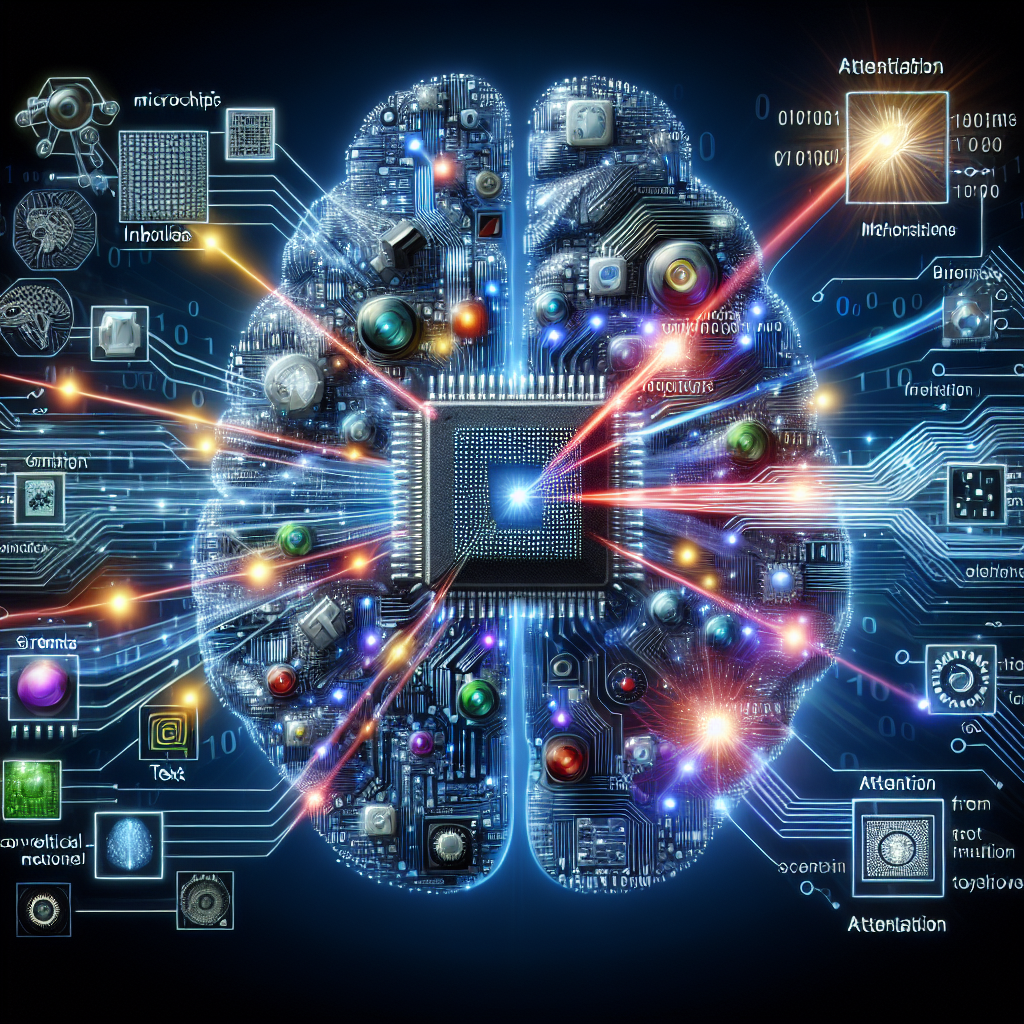
Introduction
In the age of artificial intelligence, we find ourselves at the crossroads of innovation and understanding. Imagine a world where machines can not only see but interpret the world around them, converting visual data into coherent text with remarkable accuracy. This progression moves us from vision to text, fundamentally altering how we interact with technology, empowering industries, and enhancing everyday life. Central to this transformation are attention mechanisms, a critical innovation that has propelled AI breakthroughs into the realm of possibility.
Attention mechanisms are akin to the spotlight in a dark theater, illuminating only the elements within a scene that truly matter. They empower AI models to focus on specific inputs while downplaying others, enhancing their performance across diverse applications. In this article, we will delve deep into the multifaceted role of attention mechanisms in AI, exploring their applications, analyzing case studies, and providing insights that promise to engage both novices and seasoned professionals alike.
Understanding Attention Mechanisms
What Are Attention Mechanisms?
At its core, attention mechanisms allow neural networks to prioritize certain pieces of input data over others. Traditionally, neural networks processed all inputs equally, leading to inefficiencies and reduced performance. Attention mechanisms change the game by assigning varying weights to different parts of the input data, enabling models to process information selectively.
Types of Attention Mechanisms
Attention mechanisms can be categorized into various types:
- Global Attention: Considers all parts of the input sequence to generate a weighted representation.
- Local Attention: Focuses on a specific portion of the input, ignoring irrelevant data.
- Self-Attention: Allows the model to weigh the importance of different input tokens among themselves, ideal for tasks like language translation.
These types function synergistically to enhance the model’s ability to generate accurate outputs, thus affirming the role of attention mechanisms in transforming vision into text.
The Importance of Attention in AI Models
Enhancing Performance
The implementation of attention mechanisms has significantly improved the accuracy and efficiency of AI models. For instance, natural language processing tasks that once required extensive computation now yield lightning-fast responses, thanks to attention-driven architectures.
Real-world Applications
1. Image Captioning
One of the landmark applications of attention mechanisms is in image captioning. Systems such as Google’s Show and Tell use convolutional neural networks (CNNs) in tandem with attention mechanisms to generate textual descriptions of images.
Case Study: Google’s Show and Tell
- Overview: Initially designed to generate captions for Flickr images.
- Method: Combines CNNs for feature extraction from images and recurrent neural networks (RNNs) for generating caption sequences, with a focus on the salient parts of the image.
Relevance: This application embodies the transition from vision to text, illustrating how AI can accurately interpret and describe visual data.
2. Visual Question Answering (VQA)
VQA frameworks utilize attention mechanisms to focus on relevant aspects of images when answering questions. For instance, Microsoft’s VQA model capitalizes on this by using attention to identify crucial elements of an image that relate directly to the inquiry.
Case Study: Microsoft VQA
- Overview: Enables AI to answer questions about visual content, pushing the boundaries of understanding.
- Method: Combines attention mechanisms with deep learning to evaluate both textual and visual data.
Relevance: This demonstrates a sophisticated understanding of context, proving the pivotal role of attention in articulating coherent responses rooted in visual evidence.
Representation of Information
Attention mechanisms allow for a nuanced representation of data. By emphasizing critical input portions, AI models can distill complex information down to its essence.
| Mechanism Type | Description | Use Case |
|---|---|---|
| Global Attention | Considers all inputs | Text summarization |
| Local Attention | Focuses on specific areas | Image captioning |
| Self-Attention | Weighs input tokens | Language translation |
Journey from Vision to Text
Neural Networks: The Backbone
Neural networks are the backbone of AI that generates relationships between visual and textual data. Each input is processed through multiple layers, with attention mechanisms facilitating improved data flow and communication between layers.
The Role of Transformers
Transformers represent a monumental shift in AI architectures, heavily utilizing attention mechanisms. The revolutionary model comprises encoder and decoder components, with self-attention layers allowing the model to capture contextual relationships efficiently.
Transformers in Vision-to-Text Tasks: These models leverage attention to link visual features with textual descriptions, significantly advancing capabilities in tasks such as image generation and text-based image retrieval.
Case Studies: Attention Mechanisms in Action
1. OpenAI’s CLIP
OpenAI’s CLIP (Contrastive Language-Image Pretraining) showcases the impressive capability of attention mechanisms in bridging vision and language.
- Overview: Trained on diverse datasets, CLIP learns to associate images with corresponding text descriptions.
- Method: Uses a variant of transformer architecture incorporating attention mechanisms.
Analysis: CLIP’s ability to understand and respond to queries about images exemplifies how attention mechanisms facilitate the transfer of knowledge from vision to text, effectively allowing users to interact with visual content in a coherent manner.
2. Facebook’s DINO Model
DINO (self-Distillation with No labels) explores unsupervised learning in vision, enhancing grasp on text generation through images.
- Overview: Focuses on learning effective representations of visual data without needing labeled information.
- Method: Employs attention to distill features from images, correlating them with refinement in textual context.
Analysis: This model emphasizes the potential of attention mechanisms in transforming unprocessed visual data into useful textual information, moving from raw pixels to profound meaning.
Challenges in Implementing Attention Mechanisms
Computational Demands
One of the prominent challenges associated with attention mechanisms is their computational intensity. Models equipped with attention layers require significant processing power, especially when scaling to larger datasets. Efficient implementations and optimizations are critical to ensuring that advancements remain accessible.
Contextual Limitations
While attention mechanisms excel in handling context, they are not infallible. In certain scenarios, the model may over-focus on irrelevant data, leading to inaccuracies in output.
Future Prospects of Attention Mechanisms
Advancements in AI Research
The landscape of AI continues to evolve rapidly, with attention mechanisms playing a pivotal role. Future research aims to improve the efficiency of attention models, making them more accessible and applicable across various fields, from healthcare to autonomous systems.
Interdisciplinary Applications
As we transition from vision to text, attention mechanisms hold promise in various interdisciplinary applications, including:
- Healthcare: Diagnosing conditions through visual data and summarizing findings in reports.
- Education: Tailoring learning experiences by analyzing visual inputs and generating customized textual guides.
Conclusion
The journey from vision to text is one marked by innovation driven by attention mechanisms. As we continue to refine these technologies, their role in artificial intelligence becomes increasingly significant across various industries and applications. By integrating attention mechanisms effectively, we unlock the potential for AI to narrate our world in a manner that is both intuitive and insightful.
As we look to the future, the integration of these mechanisms will pave the way for systems that not only see but also comprehend, enhancing our interaction with technology in profound ways. The call for continuous exploration and education in this field remains critical for aspiring AI practitioners eager to contribute to shaping the future.
FAQs Section
1. What are attention mechanisms in AI?
Attention mechanisms are techniques used in neural networks to focus on specific parts of the input data while processing information, improving the model’s efficiency and output quality.
2. How do attention mechanisms enhance natural language processing?
They allow models to weigh the importance of different input tokens relative to each other, resulting in more contextually relevant and coherent language outputs.
3. Can attention mechanisms be applied outside of vision-to-text tasks?
Absolutely. Attention mechanisms are versatile and can enhance various applications, from music generation to recommendation systems.
4. What challenges come with using attention mechanisms?
Challenges include their computational requirements and potential for focusing on irrelevant data, which can lead to inaccuracies in interpretation.
5. How is the future of attention mechanisms evolving in AI?
Ongoing research focuses on improving efficiency, making attention mechanisms more applicable in diverse fields and advancing AI capabilities in understanding complex data relationships.
By understanding the importance of attention mechanisms, we position ourselves not just as observers but as active participants in the future of AI—a future where technology not only interprets the world around us but also transforms how we communicate and connect with it.

















